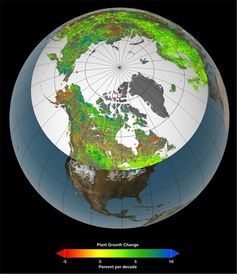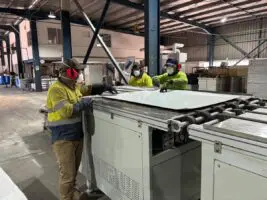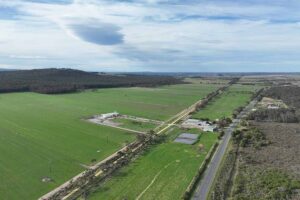It sounds logical. Plants fix carbon dioxide into sugars using light and water in the process known as photosynthesis. Therefore, extra carbon dioxide should equal more plant growth.
Plants benefit from the increased levels of carbon dioxide humans have released into the atmosphere. But this doesn’t cancel the negative effects of climate change.
Recently the argument of “CO2 as plant food” has resurfaced, suggesting that the benefits of increased CO2 to plants and agriculture outweigh the costs of climate change. But as climate science shows, the picture isn’t quite so simple.
Why do we think CO2 is fertilising plants?
The new research led by CSIRO revealed that parts of the globe are greening. To show that CO2 was responsible for more plant growth, satellite observations were analysed, removing the effect of variations in rainfall. The research found the 14% increase in CO2 between 1982 and 2010 led to a 11% increase in green foliage.

The green in this image shows where plant growth has increased over the past three decades NASA
Photosynthesis, though, is a complex process. It depends on many factors other than CO2, including sunlight, temperature, rainfall and nutrients. Some of these factors are also changing under climate change.
To start with, for every 1°C rise in temperature, relative humidity rises by 7%. Satellite data indicate that the total atmospheric moisture content over oceans has increased since 1988.
This extra moisture could see the greening of arid zones like the Atacama and Namib deserts, where specialised communities of plants rely on coastal fogs for water.
But working against humidity and increased CO2 are aerosols like sulphur dioxide. These decrease the amount of light available to plants for photosynthesis, and are also on the rise.
The bigger picture: the tropics are expanding
So far we’ve focused on relatively minor factors. But the greatest effect of climate change will be the movement and expansion of climate zones, and the process is accelerating.
The tropics are expanding north and south into the subtropical and savanna regions of the Sahara, Mexico and Western Australia. This greening is consistent with a shift in overall climate conditions to those that were previously seen in the Pliocene (5.2-2.6 million years ago). Average global temperatures were 2-3°C higher than before the Industrial Revolution, when humans starting increasing CO2 levels.

Five different studies show that the tropics are expanding. Diane J. Seidel
At the same time temperate climates are expanding into the tundra zones of the Northern Hemisphere. Thawing of the tundra and increased rainfall might allow agriculture to expand into the region.
During the Pliocene places that we now know as deserts (like the Sahara, and the Gobi in Mongolia) were largely grassy savannas. Greening of these zones on the edges of the tropics might benefit pasture.
But the shift of desert zones into temperate zones, where the bulk of the crops and livestock takes place, is leading to more droughts. Extreme weather events of all kinds are also increasing in every zone.
Overall, the effect of climate change on agriculture is likely to be negative. CO2 might fertilise plants, but it can only work where there is enough water. And as the deserts shift and droughts increase in the temperate zones used to regular rainfall, agriculture will suffer.
Andrew Glikson is Earth and paleo-climate scientist at Australian National University. He does not work for, consult to, own shares in or receive funding from any company or organisation that would benefit from this article, and has no relevant affiliations.
![]() This article was originally published at The Conversation.
This article was originally published at The Conversation.
Read the original article.








